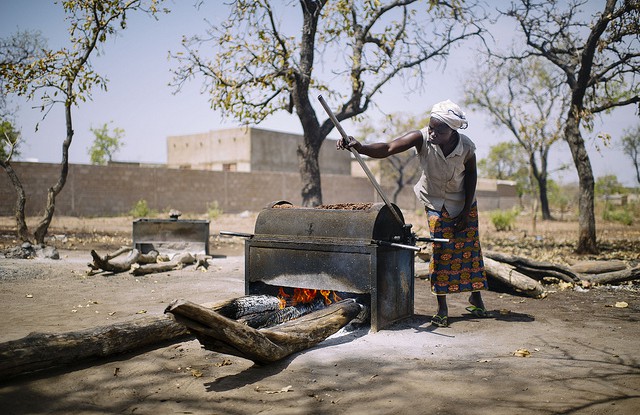
BOGOR, Indonesia (16 July, 2013) – Formal collective action can improve the livelihoods of rural smallholders and encourage sustainable production of non-timber forest products in dryland countries in West Africa, but each cooperative requires a unique structure to succeed, research shows.
Scientists with the Center for International Forestry Research (CIFOR) studied the benefits and challenges of using collaborative producer organizations as a mechanism for producing and marketing shea from Burkina Faso, frankincense (gum olibanum) from Ethiopia and honey from Zambia.
The overall aim of the CIFOR research project, funded by the Swedish International Development Cooperation Agency (SIDA), was to strengthen economic, institutional and policy incentives for sustainable forest management – part of global efforts to meet the U.N. Millennium Development Goals — eight anti-poverty targets set to expire in 2015.
“We were trying to gain a better understanding of how collective action can ensure the delivery of pro-poor outcomes in terms of improved incomes, ensure sustainable management of resources and access to resources,” said Mathurin Zida, CIFOR regional scientist and coordinator in West Africa. “We learned that there is no ‘one-size-fits-all’ strategy for rural producer organizations to achieve successful collective action.”
Not all people involved in the collection and marketing of tree products in tropical dry forests have achieved the same level of success and prosperity, said Zida, who is attending Africa Agriculture Science Week in Accra, Ghana.
“We wanted to investigate the experiences of different groups to draw lessons applicable to all agriculture-related issues for policymakers, practitioners and supporters of rural communities,” he said.
The theme of the Accra meeting is “Africa Feeding Africa through Agricultural Science and Innovation”.
“Food security could be better achieved through collective action that makes it easier for smallholders to gain access to knowledge generated by agricultural research, and by improving access to funding opportunities which are sometimes main constraints to agricultural innovations,” Zida said.
CASE-BY-CASE STUDY
Scientists studied examples of producer organizations to better understand the motives behind collaboration in tropical dry forests, which are characterized by a long dry season.
Smallholder shea, frankincense and honey industries were chosen for the study because of their broad impact.
The three commodities are traded on local, regional and international markets, identified by government and non-governmental organizations for their contribution to local livelihoods, national economies, and associated with producer organizations, said Zida, co-author of “Benefits, challenges and enabling conditions of collective action to promote sustainable production and marketing of products from Africa’s dry forests”.
Shea, collected by women from fields, is used in cosmetic products, cooking and as a substitute for chocolate. Frankincense is collected from trees by men and used in incense, food, perfume, beverages and paint.
Zambian honey, gathered mostly by men, is a sweet food converted by bees in forest hives from flower nectar for use as a spread, in medicine and beer. Honeybee-produced wax, propolis and royal jelly are put to use in the medical, dental and cosmetics industries.
POSITIVES AND PITFALLS
In all three countries, smallholder producers said their income improved if they operated as part of a collective, rather than as individuals, according to the report.
Operating as a collective, the producers gained improved access to forest resources, external support, international markets, niche markets, information, training and credit from service providers, the research showed.
For example, in Zambia, producer organizations have benefitted from a mobile phone text message service that provides access to potential buyers and prices, promoting informed bargaining.
In Ethiopia, producer organizations negotiated with authorities to gain rights to forests where access was previously restricted to private or state-owned companies.
In Burkina Faso and Ethiopia, collective action contributes to sustainable forest management through training on sustainable harvesting techniques.
On the downside, producer organizations can face a lack of accountable leadership and transparency in decision-making; underdeveloped infrastructure; lack of information on production potentials and markets; competition for land; and difficulty retaining land tenure, or management, rights, the research showed.
Constraints to market access often remain beyond the ability of producer organizations to solve, in part due to a lack of transparency in objective and rule-setting, inequality in benefit sharing, and management problems, according to the report.
For example, gum cooperatives in Ethiopia face obstacles over equality of benefit sharing because price negotiations are conducted only at the executive committee level, restricting transparency related to profit margins.
Overall, scientists established that six key factors are crucial to structuring producer organizations so that they support collective action to promote responsible forest management and product marketing practices.
Not only should producer organizations include improved access to resources and markets, but local political and socio-, economic contexts should be considered, scientists said. Accountability and transparency in decision-making and leadership are also key.
The scientists found that although collective action is important, it is not a requirement for improving production, processing and marketing of products from the dry forests in West Africa.
For more information on the issues discussed in this article, please contact Mathurin Zida at m.zida@cgiar.org.
This research was carried out as part of the project “Achieving the Millennium Development Goals in the African Dry Forests – from local action to national policy reform” generally known as the Dry Forest Project phase two (DFP II), which was supported by SIDA.
We want you to share Forests News content, which is licensed under Creative Commons Attribution-NonCommercial-ShareAlike 4.0 International (CC BY-NC-SA 4.0). This means you are free to redistribute our material for non-commercial purposes. All we ask is that you give Forests News appropriate credit and link to the original Forests News content, indicate if changes were made, and distribute your contributions under the same Creative Commons license. You must notify Forests News if you repost, reprint or reuse our materials by contacting forestsnews@cifor-icraf.org.